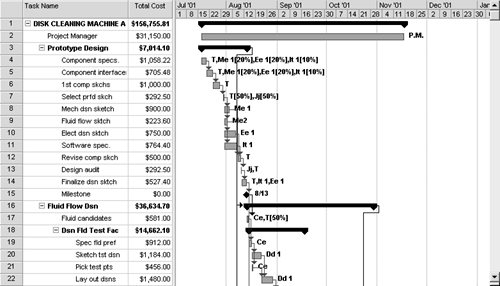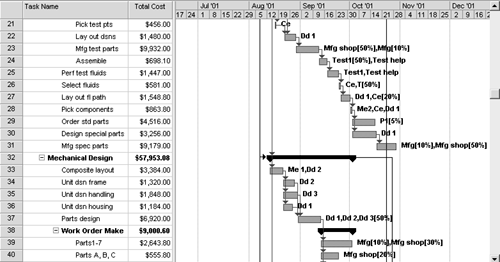| The "Disk Cleaning Machine A" project Gantt chart was displayed at the end of Chapter 6. It represents the first stage of an actual major custom manufacturer's machine-build project. It focuses on how long the project phase will take and who will execute each task. If all the team members are identified before the planning starts, the project manager can create the resource table shown in Table 10-2. If only the names or titles are entered, the rest of the page will be blank. However, if project cost is a concern, the project manager will fill in the appropriate standard rates and over-time rates for each team member or task workgroup. The rates entered come from the payroll department. To achieve accurate cost estimates, these rates can be the total cost to the company of each individual's effort this includes direct pay, social security benefits the company pays, health insurance that the company pays, and so forth. For alternative ways of entering project costs, only the individual's direct pay might be entered. Entries can be pay per month, pay per week, pay per day, or pay per hour. In Table 10-2, overtime rates are entered for hourly employees. Senior technical employees are paid by the month; some special employees are paid by the week. Neither is paid for overtime. Many of the employees are paid by the hour. The manufacturing shop, which represents several employees and some equipment use cost, is charged daily. A task may require several days in the manufacturing shop and 50 percent of available machinist effort during this time. The daily shop rate times 50 percent times the number of days required determines the cost for this task. Time estimates must be uniform. All task time estimates are entered in the same units on the Gantt chart. Days or weeks are the units from which the project managers should choose. Cost per use is not used in this set of entries. However, the manufacturing shop cost could have been entered in this column if it were desirable. The "Accrue At" column allows for how units of time are charged. Because days is the basic unit used in this Gantt chart, all standard rates are prorated according to the proportion of the employee's time, in days, that the employee works on a task. This software feature saves a lot of bookkeeping effort. Note that the base calendar "standard" entry means that all standard holidays are accounted for as nonworking days. When the resources sheet is preprepared, the software will figure the costs, task by task, as the Gantt chart is being created. If the project manager leads the team to enter the task names before the resource sheet is created, each named task resource will appear on the resource table when entered. Later, the resource rates can be entered, and the software will proceed to calculate the costs. The cost of the project plan can be developed using these procedures with the risk factor cost added as a fixed cost. When the planning is done, the baseline Gantt chart can be created. Whenever using project-planning software, the project baseline is saved and presented at the project plan review meeting. Expected project costs are displayed clearly in Figure 10-4A , 10-4B. and Figure 10-4C.
Figure 10-4A. 
Figure 10-4B. 
Figure 10-4C. 
Table 10-2. | Cleaning Machine With Costs | | ID | Resource Name | Initials | Max Units | Std. Rate | Ovt. Rate | Cost/Use | Accrue at | | 1 | P.M. | PM | 100% | $7,000.00/mon | $0.00/hr | $0.00 | Prorated | | 2 | T | TE | 150% | $5,000.00/mon | $0.00/hr | $0.00 | Prorated | | 3 | ME 1 | ME | 100% | $6,000.00/mon | $0.00/hr | $0.00 | Prorated | | 4 | EE 1 | E | 100% | $750.00/wk | $0.00/hr | $0.00 | Prorated | | 5 | IT 1 | I | 100% | $637.00/wk | $0.00/hr | $0.00 | Prorated | | 6 | JJ | J | 100% | $6,700.00/mon | $0.00/hr | $0.00 | Prorated | | 7 | ME2 | ME2 | 100% | $559.00/wk | $0.00/hr | $0.00 | Prorated | | 8 | CE | C | 100% | $57.00/hr | $77.00/hr | $0.00 | Prorated | | 9 | DD1 | D1 | 300% | $37.00/hr | $49.00/hr | $0.00 | Prorated | | 10 | Mfg | MF | 100% | $6,100.00/mon | $0.00/hr | $0.00 | Prorated | | 11 | Mfg Shop | MS | 100% | $397.00/day | $0.00/hr | $0.00 | Prorated | | 12 | Tst1 | T | 150% | $567.00/wk | $0.00/hr | $0.00 | Prorated | | 13 | Tst hlp | Th | 100% | $22.00/hr | $33.00/hr | $0.00 | Prorated | | 14 | P1 | P1 | 100% | $54.00/hr | $75.00/hr | $0.00 | Prorated | | 15 | DD2 | D2 | 200% | $33.00/hr | $46.00/hr | $0.00 | Prorated | | 16 | DD3 | D3 | 200% | $33.00/hr | $46.00/hr | $0.00 | Prorated | | 17 | P3 | P3 | 100% | $49.00/hr | $75.00/hr | $0.00 | Prorated | | 18 | Tst2 | t | 100% | $30.00/hr | $45.00/hr | $0.00 | Prorated | | 19 | P4 | P4 | 100% | $28.00/hr | $42.00/hr | $0.00 | Prorated | When the project task action begins, the base Gantt chart is opened for the entry of the actual task effort. The entry of the risk factor cost is deleted because when a task overruns and this data is entered in the operations Gantt chart, the actual overrun costs are calculated, and these costs are the ones the risk factor cost originally was entered to absorb. If a task that a carpenter is working on runs one day over, the software will calculate and charge one more day of the carpenter effort to the project. If the risk factor costs are not deleted from the working Gantt chart, the actual task overruns will be charged twice. As the completed tasks actual dates are entered on the working Gantt chart, the actual costs to date are recorded. Figures 10-4 are another view of the Gantt chart the cost view. For each task, the workers assigned to the task are charged to the task by their pay rate times the percentage of time that they work on the task times the task duration. For the first task in Figure 10-4A, "component specs," T works full time, ME1 works 20 percent of the time, EE1 works 20 percent of the time, and IT1 works 10 percent of the time. This chart tells the story of a senior technician (T) who works full time for the duration of the tasks and gets help from a specific Mechanical Engineer (ME1), a specific Electrical Engineer (EE1), and a specific Information Technology specialist (IT1). The mechanical engineer and the electrical engineer will be working 20 percent of their time on the task, and the information technology specialist will be working on the project 10 percent of the time for the life of the task. Each of these workers is paid at a monthly rate. This rate is entered on the resource chart (see Table 10-2) for each person as "Std Rate." When the rate information is entered along with the resource and time information from the Gantt chart, the software can go to work and calculate how much the project should be charged for each person's time. This data then is added together and produces the cost of $1,058.22 for this task. Note that each of these technical people are paid by the month and that costs are "Accrued at" a prorated basis. In this organization, monthly employees are not paid overtime; therefore, they have no overtime rate. Note the "Max Units" column in Table 10-2. Each of the engineer employees, indicated as ME1, EE1, and IT1, is an individual. They cannot be used on the project greater than 100 percent. The 100 percent in the Max Units column indicates that there is only one individual. However, there is one senior technician assigned to the project full time, and another senior technician is available half of the time when needed. Therefore, the Max Units column for T is 150 percent. The costs of each task is figured out in this fashion, and the total labor costs are entered in the total cost column. If there were any material costs associated with this task, this organization would enter them as "Fixed Costs" for a task, as they have for Task 23, "Manufacture test parts," in Figure 10-4A. The machine shop capacity for this task will be used at 50 percent, and the manager of manufacturing will devote 10 percent of his time to monitoring this effort during the time it is going on. These labor costs total $2,290.00. The special materials they will work on cost $7,642.00 Note that even though Task 6 and 7 in Figure 10-4A are on the critical path, there is a two-day delay between Tasks 6 and 7. Task 7 is a very short but crucial task. It is important to make the selection of the preferred sketch a very good choice. JJ is the expert who must do this, but he is not available until August 30. The material will be ready at the end of the day, August 27. The straight line for Task 6, which looks like slack, is actually an enforced project delay caused by JJ's unavailability. However, the straight horizontal lines after Tasks 8, 9, and 10 in Figure 10-4A do represent slack. Task 10 has very little slack, and if it has a large D, it will be examined as a potential noncritical path task contribution to the risk factor. (The risk factors for this project have not yet been calculated.) |